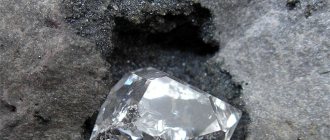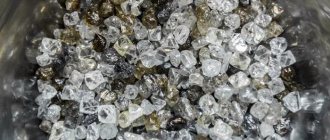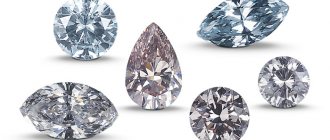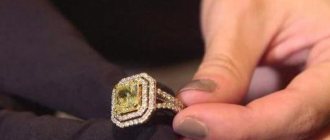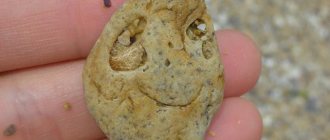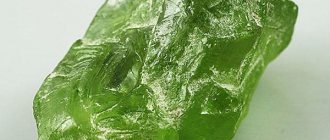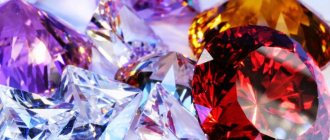Good afternoon, dear connoisseurs of precious stones. Many of you have probably held in your hands some piece of jewelry with a diamond encrusted in it. This mineral simply fascinates with its appearance, shimmering in the light with its many facets. However, few people know how diamond is formed in nature, and even scientists do not have a consensus on this matter. In this article we will discuss several hypotheses and facts that scientists provide us regarding the origin of the world's most famous gems.
How are they formed?
It was not possible to establish the exact version of the origin of gems, but the period of their origin was quite accurately determined - from 100 million to 2.5 billion years ago. Diamond is obtained from carbon under high temperature and pressure, so the depth of the deposits reaches at least 200 kilometers. Scientists have been studying this issue for a long time and have put forward several theories:
The first version is the idea of diamonds appearing on the surface of the earth. According to it, the mineral was the result of contact between erupted frozen magma and hydrocarbons. This led to the formation of a high-density crystal lattice.
Most scientists are inclined to believe that the origin of diamonds is associated with ultramafic rock. When a volcano erupts, the lava that comes out throws stones to the surface - these are diamonds in their natural form.
The earth's crust contains a lot of diamonds, but industrial mining can be carried out in a limited number of deposits. One of the popular places to search for precious stones is volcanoes after an eruption, where there is a high chance of finding a valuable mineral. However, the extraction process must be carefully prepared; this requires specialized equipment.
Diamonds of earthly origin
The origin of diamonds is still unclear, and there is still much debate on this matter. Only one thing could be determined precisely—the place and time of their formation. Most scientists agree that diamonds arose in the mantle of our planet between 100 million and 2.5 billion years ago. Carbon at a depth of 200 km under the influence of temperatures of 1300 ° C and at a pressure of 4-5 GPa gradually formed a diamond crystal lattice. There are known cases of the formation of diamond deposits at a depth of 700 km.
The most popular theories according to which diamonds are formed in volcanic rocks:
- Carbon got into the solidifying magma as part of hydrocarbons, and this is how diamonds appeared in the upper layers of the crust of our planet.
- The non-metal crystallized very deeply - at the depth of ultrabasic rocks, after which the deposits were carried upward by magma flows.
- The last theory is the most popular. The bulk of the crystals arose in ultramafic rock, and some diamonds arose already in the process of ascent of this rock to the surface of the crust.
A real diamond is a non-metal that is actually not that rare. The reason for its high cost is that only a small number of deposits are accessible to humanity, while the main deposits are located too deep underground.
Where do diamonds come from in meteorites?
The hypothesis about the meteorite origin of the mineral caused heated discussions, because diamonds were found in some specimens. Today, the overwhelming majority of scientists are inclined to believe that diamonds in meteorites arose as a result of impacts in the asteroid belt. When falling to the ground, a new rock was formed on the surface of the latter - impactites, the conditions for the formation of which correspond to those of diamonds. The particles involved in the impact contain carbon, which under the influence of pressure of 40-50 GPa and temperature of 2-3 thousand degrees Celsius can become diamond.
Impact deposits are a common phenomenon and originated several million years ago. One of the most famous is the Popigai astroproblem, whose diameter reaches 100 km. It is located on the border of modern Krasnoyarsk and Yakutia; the meteorite that fell there had a radius of 3.5 km. At the same time, the extraction of meteorite diamonds is not feasible for industry - they are too small.
Diamonds of meteorite origin
One would think that precious stones literally flew to Earth from space, but this is not so - only tiny inclusions of precious crystals were found in the metal and stone meteorites found. The vast majority of minerals of meteorite origin were formed as a result of the impact of meteorites on the earth's surface.
For the first time, diamonds were found in meteorites by Russian scientists back in 1888 in Mordovia. M.V. Erofeev and P.A. The Lachinovs were at that time studying a relatively small meteorite called New Uraeus.
Minerals in iron meteorites were found a little later and on the other side of the world - in 1891 in the USA, in the state of Arizona. A giant meteorite weighing 30 tons crashed to the ground where the state is now located, about 40 thousand years ago.
The origin of diamonds in space still remains a mystery; there are several hypotheses on this matter. So far, humanity has not been able to find and accurately identify diamond asteroids or planets. Most scientists are inclined to believe that crystals are formed when celestial bodies collide with each other.
How is mining done?
Mining diamonds from scratch is a complex and labor-intensive process that includes several stages. First you need to find a deposit and start developing it, and not every deposit contains diamonds suitable for mining. After completing the preliminary work, the extraction of ore begins. It is mined using machinery and then crushed. In this state, it becomes possible to extract kimberlite rock from it, which is the goal of primary processing.
The kimberlite is then sent to production, where it is sorted according to several parameters to accurately determine its class and size. An important criterion is the suitability of the stone for jewelry work or various devices. Despite the distribution of kimberlite ore almost throughout the globe, its reserves are greatest in Russia, Canada and Botswana. The first attempts to mine diamonds were made back in the 17th century and were very successful.
STRUCTURE
Crystal structure of diamond
Diamond system is cubic, space group Fd3m. The elementary cell of the diamond crystal lattice is a face-centered cube, in which carbon atoms are located in four sectors arranged in a checkerboard pattern. Otherwise, the diamond structure can be represented as two cubic face-centered lattices, offset relative to each other along the main diagonal of the cube by a quarter of its length. A structure similar to diamond is found in silicon, a low-temperature modification of tin and some other simple substances. Diamond crystals always contain various defects in the crystal structure (point, linear defects, inclusions, subgrain boundaries, etc.). Such defects largely determine the physical properties of crystals.
Place of Birth
Diamond deposits are of two types: primary in the form of kimberlite and lamproite pipes and placers. The latter are secondary deposits; they are formed during the destruction of primary deposits. In the vast majority of cases, mining occurs in tubes. Lamproite pipes are a type of igneous rock; large deposits of them were found in Australia at the end of the 20th century. However, the find did not bring much wealth - the diamonds turned out to be so tiny that it was impossible to use them for jewelry. Their use is 90-95% aimed at industrial purposes. A unique deposit is Argyle, where the rarest pink diamonds were discovered.
Kimberlite pipes are common in Russia, Canada and Africa - in the latter they were found first. It was there that an 85-carat diamond was found in the 19th century, causing a sensation among gem seekers. The diamond fever led to the discovery of a stone weighing 428.5 carats a few years later - it was named “De Beers”. The only place where there are no diamond deposits is Antarctica, which is logical, given the specifics of their formation.
DIAMOND DE BEERS
How to distinguish from quartz?
Among the minerals there are many similar in appearance, which scammers take advantage of. They pass off a cheap analogue as a rare and expensive stone - for example, quartz instead of diamond. With a cursory examination, only a jeweler will be able to distinguish a fake, but the buyer needs to know several basic differences between them.
- It is easiest to check a completely transparent stone. To do this, you need to lower it into a glass of clean water and carefully examine it. After such a procedure, quartz will be “lost”, becoming invisible. The diamond will retain its outline. This verification method is not suitable for color copies.
- Diamond is one of the hardest minerals; quartz cannot compare to it in this regard. Therefore, if you apply strong pressure to the last stone, it will certainly become deformed. It is enough to squeeze the stone being tested between two coins and move them to the sides. There will not be a scratch on a real diamond.
- Steam on the surface of a diamond does not condense; just breathe on it to be convinced of this. If droplets appear on it, it is quartz. This simple method is convenient for determining authenticity in jewelry stores.
- It is impossible to read text through a diamond; it strongly refracts light. But through quartz the letters look correct and undistorted.
The latter method is unlikely to be performed in a jewelry store, but it can be done at home. To do this, you need to drop quite a bit of water onto one face of the proposed diamond. Then run a thin needle along its surface - if the drop spreads, it is quartz.
How to distinguish from a fake?
Diamonds are identical in appearance to many minerals, while being the rarest and most expensive. Among the stones most often used for making counterfeits are:
- Rhinestone;
- White zirconium;
- Quartz;
- Topaz.
Synthetic materials (cubic zirconia, for example) are easy to distinguish from the original by their cut and shine - they are more like zirconium. Their transparency and hardness are several orders of magnitude lower.
The main difference between diamond and other stones is its high hardness. It can cut glass and withstand sandpaper or a knife blade without scratching. Even with a strong blow, it will not break - not a single fake will survive such tests.
There is an opinion that a diamond can be easily distinguished by the fact that it heats up slowly in the hand - low heat capacity. But many semi-precious stones have the same property, so the method is applicable only to synthetic fakes.
Diamond does not attract dust and will not dissolve even in hydrochloric acid. It is difficult to discern the text through it; in the water it does not lose its outline. The shine of a diamond is grayish, with a white sheen. It is a misconception to believe that it shimmers with the colors of the rainbow.
Synthetic minerals
People have long dreamed of learning how to create this non-metal on their own, but this only happened in the 20th century. Carbon, or more precisely its source - graphite, is subjected to extreme pressure and high temperature. This occurs using a hydraulic press and electric current. Forming diamonds this way is reliable, but expensive.
There are two more methods by which artificial “kings of stones” appear: by exposure to an explosion and by growing crystals in a methane environment. Artificial minerals are more often used in production than in jewelry, although they are in no way inferior to natural ones.
The basis of production, carbon, is a very common material, so there are no problems with the extraction of raw materials for the artificial creation of stones. In terms of price, quality and availability, the best raw material is graphite, which is why it is used most often.
By the way, the synthetic production of such stones contributed to the discovery of a new, even more durable material. It was called ACNR. This stone, which can also be formed from carbon through heat, can even scratch a diamond. Perhaps future generations will widely use it in practice.
